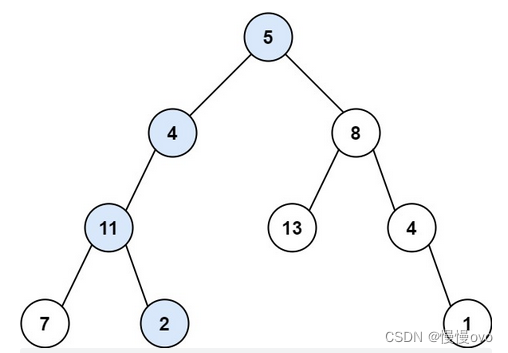题目描述:
给你二叉树的根节点 root 和一个表示目标和的整数 targetSum 。判断该树中是否存在 根节点到叶子节点 的路径,这条路径上所有节点值相加等于目标和 targetSum 。如果存在,返回 true ;否则,返回 false 。
叶子节点 是指没有子节点的节点。
初始代码:
/**
* Definition for a binary tree node.
* public class TreeNode {
* int val;
* TreeNode left;
* TreeNode right;
* TreeNode() {}
* TreeNode(int val) { this.val = val; }
* TreeNode(int val, TreeNode left, TreeNode right) {
* this.val = val;
* this.left = left;
* this.right = right;
* }
* }
*/
class Solution {
public boolean hasPathSum(TreeNode root, int targetSum) {
}
}示例1:

输入:root = [5,4,8,11,null,13,4,7,2,null,null,null,1], targetSum = 22
输出:true
解释:等于目标和的根节点到叶节点路径如上图所示。
示例2:

输入:root = [1,2,3], targetSum = 5
输出:false
解释:树中存在两条根节点到叶子节点的路径:
(1 --> 2): 和为 3
(1 --> 3): 和为 4
不存在 sum = 5 的根节点到叶子节点的路径。
示例3:
输入:root = [], targetSum = 0 输出:false 解释:由于树是空的,所以不存在根节点到叶子节点的路径。
参考答案:
/**
* Definition for a binary tree node.
* public class TreeNode {
* int val;
* TreeNode left;
* TreeNode right;
* TreeNode() {}
* TreeNode(int val) { this.val = val; }
* TreeNode(int val, TreeNode left, TreeNode right) {
* this.val = val;
* this.left = left;
* this.right = right;
* }
* }
*/
class Solution {
public boolean hasPathSum(TreeNode root, int targetSum) {
if(root == null) return false;
//这题的做法和层序遍历相同 即广度优先遍历
Queue<TreeNode> node = new LinkedList<>();//用来存储节点
Queue<Integer> value = new LinkedList<>();//用来存储每个节点的值
node.offer(root);//默认将根节点先放入
value.offer(root.val);//默认将根节点的值先放入
while(!node.isEmpty()){
TreeNode n = node.poll();//取出存储的节点
int v = value.poll();//取出存储的值
//题目是求根节点到叶子节点的路径 所以需要这样判断
if (n.left == null && n.right == null) {
if (v == targetSum) return true;
continue;
}
if(n.left != null){
node.offer(n.left);
value.offer(n.left.val + v);
}
if(n.right != null){
node.offer(n.right);
value.offer(n.right.val + v);
}
}
return false;
}
}/**
* Definition for a binary tree node.
* public class TreeNode {
* int val;
* TreeNode left;
* TreeNode right;
* TreeNode() {}
* TreeNode(int val) { this.val = val; }
* TreeNode(int val, TreeNode left, TreeNode right) {
* this.val = val;
* this.left = left;
* this.right = right;
* }
* }
*/
//官方解法 遍历 效率提高了
class Solution {
public boolean hasPathSum(TreeNode root, int targetSum) {
if (root == null) return false;
//根节点到叶子节点
if (root.left == null && root.right == null) return targetSum == root.val;
//遍历左子树或者右子树成功一个即可
return hasPathSum(root.left, targetSum - root.val) ||
hasPathSum(root.right, targetSum - root.val);
}
}